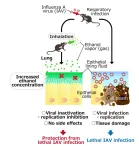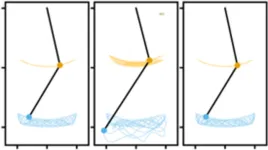(Press-News.org) Inhaling low concentrations of ethanol vapor can disable the influenza A virus in mice, without harmful side effects, says a new study by scientists at the Okinawa Institute of Science and Technology (OIST). The scientists believe it may also treat similar viruses such as the one that causes Covid-19.
Prof. Tsumoru Shintake, who leads the Quantum Wave Microscopy Unit at OIST, first proposed the idea to use ethanol vapor to treat respiratory tract infections. He set out to test the approach with his colleague, Prof. Hiroki Ishikawa, leader of the Immune Signal Unit at OIST, and their team members.
“Ethanol is an effective disinfectant for body surfaces, so we wanted to know whether ethanol could also be effective inside the body,” said Dr. Miho Tamai, a scientist in Prof. Ishikawa’s lab.
Using a humidifier to produce ethanol vapor in a small container, they found that when mice infected with influenza A inhale the vapor for ten minutes, the virus is inactivated. The study is published in The Journal of Infectious Diseases.
Influenza A viruses accumulate in a thin fluid layer covering lung cells that protect the surface of the airway. The scientists think that the ethanol vapor must increase ethanol concentrations in the fluid to 20% to successfully treat the infection. This concentration is not toxic to lung cells the scientists created in the lab to mimic human cells. At body temperature, 20% ethanol can not only inactivate the influenza A virus outside of the cells in one minute, but also stop the virus from replicating inside these cells.
The concentration of ethanol provided is important. If the concentration does not reach the right level to inactivate viruses, it will not be useful.
Influenza A is a virus that has an outer membrane, called an envelope. “Ethanol vapor may also inactivate other enveloped viruses such as SARS-CoV-2,” Prof. Ishikawa said, and so far, all viruses that have caused pandemics have been enveloped. “Once the next pandemic happens, maybe we can quickly apply the ethanol vapor inhalation therapy to prevent or cure the disease,” he explained.
Prof. Shintake agreed, noting that the effectiveness of this method does not depend on the variant of the virus. He explained that if designed carefully, an ethanol vapor inhalation method could possibly stop a pandemic in future. He and Prof. Ishikawa will continue to collaborate to optimize the therapy and to investigate its effects on other respiratory infectious diseases such as avian influenza viruses and SARS-CoV-2.
The researchers believe that ethanol vapor inhalation treatment has great potential as a versatile and cost-effective new therapy against various respiratory infectious diseases. But Prof. Ishikawa cautioned that people should not try using ethanol as a therapy on their own. “That may lead to serious side-effects or explosion risks,” he said. “The efficacy and safety of this new treatment on humans and other mammals should be carefully evaluated in the future.”
END
Inhaled ethanol may treat respiratory infections and stop pandemics
In mice, the treatment decreased infections caused by the Influenza A virus
2023-04-27
ELSE PRESS RELEASES FROM THIS DATE:
Air-breathing cathode enhances energy conversion efficiency and durability of alkaline nickel-zinc batteries
2023-04-27
Nickel-zinc (Ni-Zn) batteries are promising due to their high output voltage, high theoretical specific energy, high safety, and low cost. However, rechargeable alkaline Ni-Zn batteries are challenging, since the cathodic side reaction of oxygen evolution results in low energy efficiency and poor stability.
Recently, a research group led by Prof. YANG Weishen and Dr. ZHU Kaiyue from the Dalian Institute of Chemical Physics (DICP) of the Chinese Academy of Sciences proposed ...
Methanol biotransformation to efficiently produce fatty alcohols
2023-04-27
Methanol is a potential feedstock for biomanufacturing since it's easily obtained in an environment-friendly manner. But it is still challenging to construct a microbial cell factory for methanol-based bioproduction due to the toxicity of methanol and complex cellular metabolism.
Recently, a research group led by Prof. ZHOU Yongjin from the Dalian Institute of Chemical Physics (DICP) of the Chinese Academy of Sciences (CAS) has engineered yeast Ogataea polymorpha for efficient ...
Duke-NUS, IMH: Cost of anxiety and depression in Singapore runs into the billions
2023-04-27
SINGAPORE, 26 April 2023 – Symptoms of anxiety and depression in the post-peak pandemic era could be costing Singapore 2.9 per cent of its gross domestic product (GDP)—or nearly S$16 billion—suggests a study conducted by Duke-NUS Medical School and the Institute of Mental Health (IMH).
Publishing in the journal BMC Psychiatry, the researchers estimated the total economic burden of lost productivity due to anxiety and depression in Singapore to be S$15.7 billion (US$11.72 billion) annually, based on survey data from 5,725 Singaporean adults collected via an online panel between April and June 2022.
Using ...
Maths unlocks molecular interactions that open window to how life evolved
2023-04-27
Dr Araujo, from the QUT School of Mathematical Sciences, said the research findings represented a blueprint for adaptation-capable signalling networks across all domains of life and for the design of synthetic biosystems.
“Our study considers a process called robust perfect adaptation (RPA) whereby biological systems, from individual cells to entire organisms, maintain important molecules within narrow concentration ranges despite continually being bombarded with disturbances to the system,” Dr Araujo ...
The conservation laws of a dynamical system are no mystery to artificial intelligence
2023-04-27
Osaka, Japan – Many real-world systems, from climate systems to the physical mechanisms of robots, are governed by the invariant quantities that arise from their underlying geometric structures. Modelling these systems using computer simulations is a key tool for understanding them (for weather forecasting, for instance, or developing robot locomotion). It’s often possible to collect data for these systems, but making sense of those data to build a model is a more challenging task.
Artificial intelligence ...
Infectious-diseases response initiative reduced staff burnout and helped prevent HAI increases at VA health care system during covid-19 pandemic
2023-04-27
Arlington, Va., April 27, 2023 – A serious infectious threat response initiative (SITRI) implemented by the Infection Prevention and Control (IPC) team at Veterans Affairs North Texas Health Care System (VANTHCS) positively impacted IPC staff burnout and helped prevent an increase in healthcare-associated infections (HAIs) during the COVID-19 pandemic. The findings, published today in the American Journal of Infection Control (AJIC), suggest that pre-emptive investment in preparedness initiatives can enable healthcare facilities to retain routine prevention efforts and improve patient safety during infectious disease outbreaks.
“During ...
Former EPA and NIEHS directors urge overhaul of WHO’s draft PFAS drinking water guidance
2023-04-27
The World Health Organization’s draft drinking water guidance for the two most well-studied per- and polyfluoroalkyl substances (PFAS) exhibit a “striking and inappropriate disregard of the best available science,” according to former directors of the U.S. EPA’s Office of Science and Technology and the National Institute of Environmental Health Sciences (NIEHS). In a viewpoint for the peer-reviewed journal Environmental Science & Technology, Betsy Southerland and Linda Birnbaum strongly recommend ...
Using microbes to get more out of mining waste
2023-04-27
Researchers have developed a new mining technique which uses microbes to recover metals and store carbon in the waste produced by mining. Adopting this technique of reusing mining waste, called tailings, could transform the mining industry and create a greener and more sustainable future.
Tailings are a by-product of mining. They are the fine-grained waste materials left after extracting the target ore mineral, which are then stacked and stored. This method is called dry-stack tailing.
Over time, mining practices have evolved and become more efficient. But the climate crisis and rising demand for critical minerals require the development of new ore removal and ...
Carnegie Mellon research aims to revive office chatter
2023-04-26
About one-third of our lives are spent at work, and the relationships we build there can have personal and professional benefits. But a majority of workers indicate difficulty connecting with co-workers socially, especially in the new landscape of remote and hybrid work arrangements.
To ease the friction caused by reduced in-person interaction, a team of researchers from Carnegie Mellon University's Human-Computer Interaction Institute created a Slack application that helps to initiate casual conversations and create affinity groups in an online workspace.
"We were freshly out of the pandemic, and we realized that everyone around us was complaining ...
Differential silencing of STAT3 isoforms leads to changes in STAT3 activation
2023-04-26
“Our study emphasizes the importance of distinguishing between STAT3α and STAT3β proteins and their active forms when discussing STAT3-related cancer diagnosis and therapy.”
BUFFALO, NY- April 26, 2023 – A new research paper was published in Oncotarget's Volume 14 on April 24, 2023, entitled, “Differential silencing of STAT3 isoforms leads to changes in STAT3 activation.”
Signal transducer and activator of transcription 3 (STAT3) is a transcription factor involved in ...
LAST 30 PRESS RELEASES:
New modeling approach sheds light on rare gut disease
Study documents potentially hazardous flame retardants in firefighter gear
Can certain bacteria regulate aging of the immune system and its related alterations?
AI model helps diagnose often undetected heart disease from simple EKG
There are fewer online trolls than people think
Cell membrane fluctuations produce electricity
Jeonbuk National University study shows positive parenting can protect adolescents against self-harm
Surface-engineered ZnO nanocrystals to tackle perfluoroalkyl substance contamination
This new understanding of T cell receptors may improve cancer immunotherapies
A new fossil face sheds light on early migrations of ancient human ancestor
A new immunotherapy approach could work for many types of cancer
A new way to diagnose deadly lung infections and save lives
40 percent of MRI signals do not correspond to actual brain activity
How brain-inspired algorithms could drive down AI energy costs
Gum disease may be linked to plaque buildup in arteries, higher risk of major CVD events
Contrails are a major driver of aviation’s climate impact
Structure of dopamine-releasing neurons relates to the type of circuits they form for smell-processing
Reducing social isolation protects the brain in later life
Keeping the heart healthy increases longevity even after cancer
Young adults commonly mix cannabis with nicotine and tobacco
Comprehensive review illuminates tau protein's dual nature in brain health, disease, and emerging psychiatric connections
Book prepares K-12 leaders for the next public health crisis
Storms in the Southern Ocean mitigates global warming
Seals on the move: Research reveals key data for offshore development and international ecology
Sports injuries sustained during your period might be more severe
World's first successful 2 Tbit/s free-space optical communication using small optical terminals mountable on satellites and HAPS
Can intimate relationships affect your heart? New study says ‘yes’
Scalable and healable gradient textiles for multi‑scenario radiative cooling via bicomponent blow spinning
Research shows informed traders never let a good climate crisis go to waste
Intelligent XGBoost framework enhances asphalt pavement skid resistance assessment
[Press-News.org] Inhaled ethanol may treat respiratory infections and stop pandemicsIn mice, the treatment decreased infections caused by the Influenza A virus




